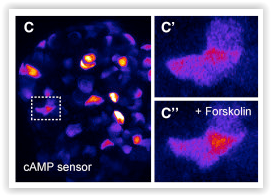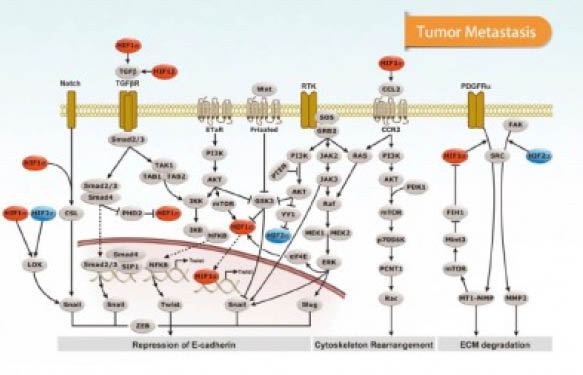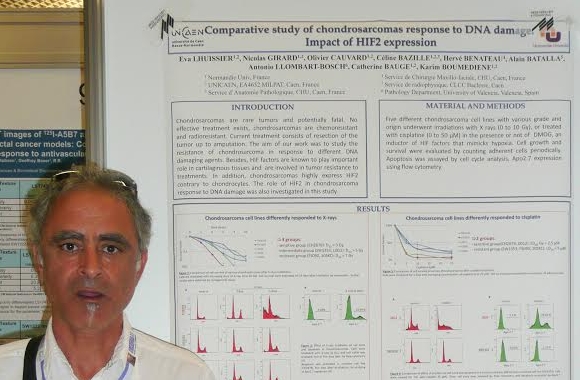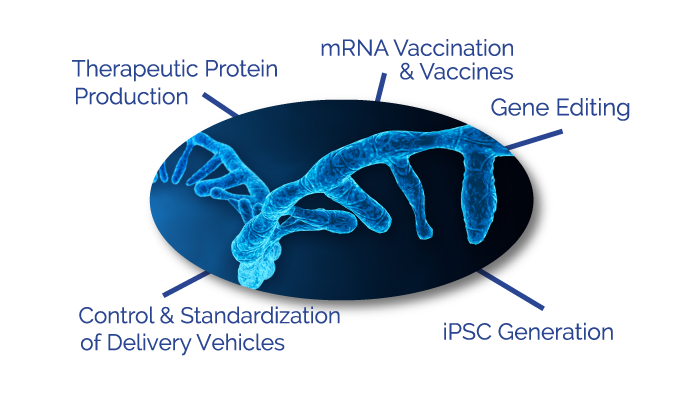In a recent publication, researchers from the University of Miami Miller School of Medicine (USA) describe that Serotonin released by human beta cell inhibits glucagon secretion by alpha cells. They demonstrated that this paracrine loop was mediated via the cAMP pathway. To do so, they captured in live human pancreatic islet cells cAMP signals using a specific fluorescent biosensor.

In this paper, Almaça et al. observed that when stimulated with increases in glucose concentration, human beta cells release serotonin in their neighbourhood. This release inhibits glucagon secretion by lowering cAMP in alpha cells via 5-HT1F receptors. Interestingly, in diabetic mouse models, the activation of these receptors reduces hyperglycemia. The authors demonstrated the existence of a 5-HT-based paracrine signal released by human pancreatic beta cells able to regulate glucagon secretion.
These data suggest that the serotonin pathway in alpha cells could be therapeutically promising targets in the future for diabetes via glucagon modulation.
A key feature in this paper was the use of a genetically encoded fluorescent biosensor for live cell discovery that can be easily deployed in live primary cultures of cells, here human pancreatic islets, to uncover cAMP, DAG, PIP2, Ca2+and voltage changes by fluorescent live cell imaging.
With the ability to investigate cAMP signaling in the human islet, the Miami research team was able to unravel the effects of serotonin on glucagon secretion via cAMP signaling in pancreatic islets.
To measure cAMP, human pancreatic islets (like those available at Prodo Laboratories via tebu-bio in Eruope) were infected for 24 hours with a baculovirus encoding a cAMP sensor (cADDis cAMP Assay) for cell signaling studies designed by Montana Molecular. Islets were imaged 48–72 hr later on a confocal microscope.
The bright fluorescence produced by cADDis (and documented in Figure 5 of the publication) showed that 5-HT released by beta cells lowers cAMP in the neighbouring alpha cells.

Because cADDis indicates dynamic changes in cAMP, Dr Caicedo’s team was able to see that 5-HT produces a unique effect. Unlike other paracrine regulators, serotonin produces a rapid and direct decrease in cAMP, quickly shutting down glucagon secretion in response to rising glucose.
Montana Molecular have chosen tebu-bio to market their products in Europe. Their products are used for drug discovery to observe and measure cell signaling processes. Many thanks to Vladlen Slepak and Anne-Marie Quin for notifying us about this publication!
About the cADDis cAMP Assay:
cADDis (red or green) fluorescent biosensor detects cAMP in living cells and in real-time enabling the measure of kinetic responses with no cell lysis. GPCR pathway analysis can be preformed by combining with Ca2+ or DAG biosensors also available for simultaneous pathway readout.
Montana Molecular’s biosensor assays are most commonly used on automated fluorescence plate readers, however, Vlad Slepak (Professor of Molecular and Cellular Pharmacology University of Miami School of Medicine) explains the advantages of using biosensors in live cell imaging applications with cultures of pancreatic islet cells.
Here is what he says about cADDis:
“The best thing about Montana Molecular’s biosensors has been the ease of use. My lab has already been doing live cell imaging, mostly free Ca2+. All we have to do is add a BacMam vector to the cells and use the same microscope set-up to gather data on PIP2, DAG and cAMP.”
Vladlen Z Slepak, PhD Professor of Molecular and Cellular Pharmacology University of Miami School of Medicine
Interested in more information about these highly innovative kits? Don’t hesitate to contact me through the form below for further information.
Source: Almac J. et al. (2016) “Human Beta Cells Produce and Release Serotonin to Inhibit Glucagon Secretion from Alpha Cells” Cell Reports 17, 3281–3291
December 20, 2016 (http://dx.doi.org/10.1016/j.celrep.2016.11.072)



